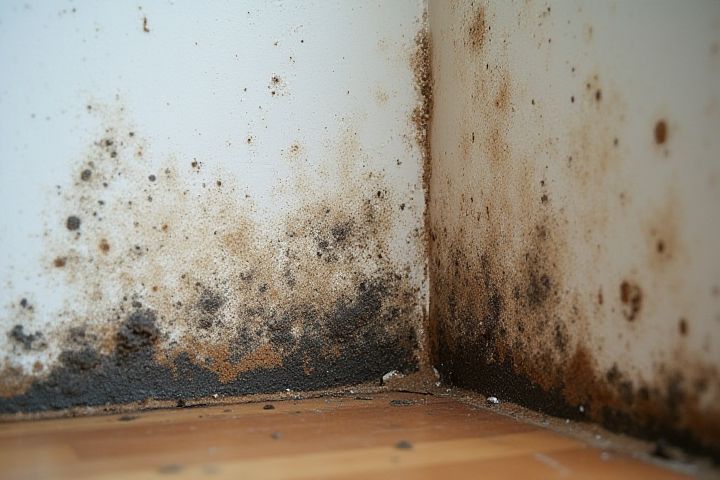
Mold growth in your house is often caused by excess moisture, typically from leaks, high humidity, or poor ventilation. Common sources include water damage from roof leaks, condensation on windows, or damp basements. Warm, humid environments, such as bathrooms and kitchens, provide ideal conditions for mold spores to thrive. If you notice a musty odor or visible mold patches, addressing the moisture issue is crucial for effective remediation. Regularly checking areas prone to dampness can help prevent mold from becoming a persistent problem in your home.
Why Is Mold Growing In My House
High humidity levels
High humidity levels, often exceeding 60%, create an ideal environment for mold growth in your home. This excess moisture can stem from sources such as poor ventilation, leaks, or even everyday activities like cooking and showering. To combat mold, you should maintain indoor humidity levels between 30% and 50%, using dehumidifiers or air conditioners if necessary. Regularly checking areas prone to moisture, such as basements and bathrooms, can help prevent mold infestations and protect your home.
Poor ventilation
Poor ventilation is a primary contributor to mold growth in your house, as it restricts the flow of fresh air and allows moisture to accumulate. Areas with insufficient airflow, such as basements and attics, can trap humidity levels above the ideal range of 30-50%, creating a perfect environment for mold spores to thrive. When organic materials, like wood or drywall, become damp and the relative humidity exceeds 60%, mold can begin to develop within 48 hours. Regularly opening windows, using exhaust fans, and installing air purifiers can significantly improve ventilation and reduce the likelihood of mold infestations.
Water leaks or damage
Water leaks or damage are primary contributors to mold growth in homes, thriving in damp environments with over 60% humidity. Even a small leak from plumbing, roofs, or windows can create moist conditions conducive to mold proliferation. Within 24 to 48 hours of water exposure, mold spores can begin to settle and multiply, leading to potential health risks and structural damage. Inspect your home regularly for signs of water leaks, such as discoloration on walls or ceilings, to prevent mold from developing and help maintain a safe living environment.
Condensation on windows
Mold growth in your home often results from condensation, particularly noticeable on windows. When warm, moist air inside your house comes into contact with the colder surface of a window, it cools down and loses its capacity to hold moisture, resulting in water droplets forming. This creates an ideal environment for mold spores, which thrive in humid conditions, to settle and proliferate. To address this issue, reducing indoor humidity levels to below 50% using dehumidifiers or managing air circulation can significantly mitigate mold growth risks.
Inadequate insulation
Inadequate insulation can lead to significant moisture build-up within your home, creating an ideal environment for mold growth. Poorly insulated walls, attics, and basements allow heat to escape, causing condensation on colder surfaces. The combination of higher humidity levels and trapped moisture can result in mold colonies developing, which may impact indoor air quality and trigger health issues. To mitigate this risk, consider enhancing your insulation systems, particularly in areas prone to temperature fluctuations.
Organic material presence
Mold thrives in environments where organic materials are readily available, as they provide essential nutrients for growth. Common organic materials found in homes include wood, paper, fabric, and food remnants, which can retain moisture and encourage mold proliferation. High humidity levels, often caused by poor ventilation or water leaks, further exacerbate the growth of mold on these surfaces. To prevent mold, it's crucial to reduce moisture levels and ensure that organic materials are dry and properly stored.
Poor drainage around home
Poor drainage around your home can create an environment conducive to mold growth, as excess moisture becomes trapped in the soil surrounding your foundation. When rainwater accumulates or a malfunctioning gutter system fails to direct water away from your property, it can seep into the foundation and lead to dampness in your walls and floors. This persistent moisture provides an ideal breeding ground for mold spores, which thrive in dark, humid conditions. To safeguard your home, consider implementing proper drainage solutions such as installing French drains, ensuring gutters are clear, and grading your yard to promote effective water runoff.
Flooding history
Mold thrives in environments with high moisture levels, making homes affected by flooding particularly vulnerable. After a flood, damp surfaces and the retained humidity can foster mold growth within 24 to 48 hours. Even after professional remediation, if your home has a history of flooding, ongoing moisture issues could resurface, creating a recurrent mold problem. Regularly monitoring humidity levels and promptly addressing any water intrusion can help protect your living space from this persistent issue.
Closet, attic, or basement conditions
Mold growth in your house, particularly in closets, attics, or basements, often stems from high humidity levels and inadequate ventilation. These enclosed spaces frequently trap moisture from activities like laundry or cooking, creating an ideal environment for mold spores to thrive. Dark, damp conditions found in attics or basements further contribute to the problem, as they are less exposed to sunlight and air circulation. Regularly inspecting these areas for leaks, maintaining optimal humidity levels, and ensuring proper ventilation can significantly reduce mold risks in your home.
Infrequent cleaning
Infrequent cleaning can lead to mold growth in your house by allowing moisture, dust, and organic materials to accumulate, creating an ideal environment for mold spores. Dust and dirt can retain moisture, especially in areas like bathrooms and kitchens, where humidity levels are typically higher. If you clean less often, forgotten corners and hidden spaces may stay damp, encouraging mold to thrive. Regular cleaning, particularly in high-moisture areas, can significantly reduce the chances of mold proliferation and improve your indoor air quality.
